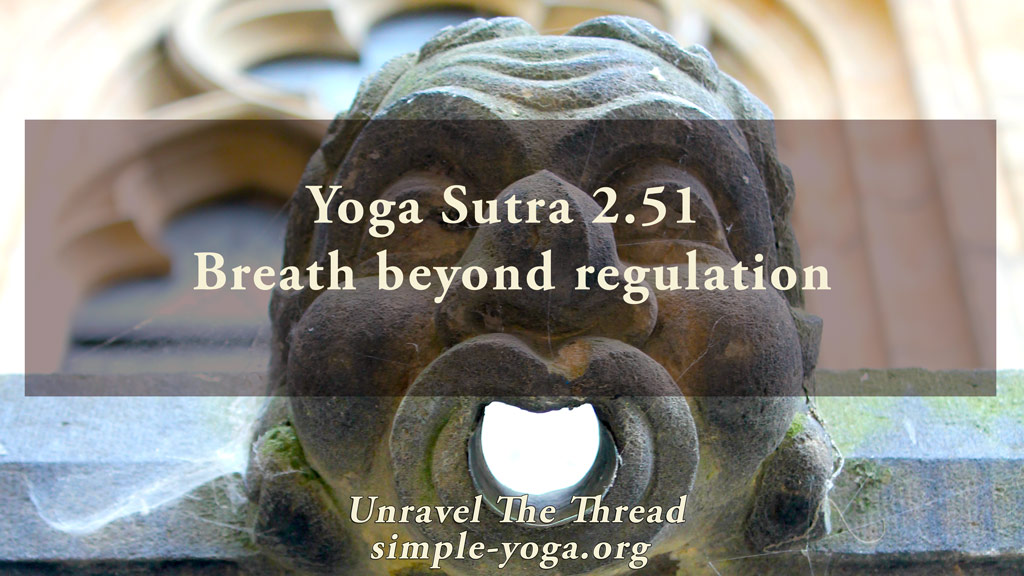
2.50 Systematic long and subtle breathing
March 29, 2021
2.52 Brighter inner light
April 19, 2021
2.50 Systematic long and subtle breathing
March 29, 2021
2.52 Brighter inner light
April 19, 20212.51 Breath beyond regulation

2.51 The fourth type of breath is beyond internal and external regulation.
The whole yoga project is a journey that moves you from the gross, outermost level of experience to subtler and deeper levels of internal experience. That is one reason for practicing asana, to gain enhanced awareness of bodily processes and then to deepen the practice with pranayama in order to explore and feel the breath and the vital force that it carries. After presenting the definition of pranayama in sutra 2.49 and the variables that are observed and manipulated in sutra 2.50, this aphorism introduces another type of breathing. This fourth type of breath is known as kevala kumbhaka, a pure and effortless state of breath retention. However, it is important to notice that this sutra also says that it is beyond regulation. In other words, this is a special kind of breath that happens spontaneously without any forcing or manipulation. In Sanskrit, meanings of kevala include alone, isolated, simple, pure, entire, whole, and the doctrine of the absolute unity of spirit. Some sources suggest that this fourth type of breath is the result of the mind being still, while others indicate that it is an experience of connecting to the subtlest aspects of respiration. Yoga lore suggests that this type of breath may be related to the legendary ability of master yogis to stop their own heart for brief periods of time. This may have been a result of the close relationship between breathing and heart function. This highest form of breath retention points to a deeper connection to the subtlety of the breath and of the life force. As author Gregor Maehle suggests, it is not coincidental that Patanjali calls kevala kumbhaka the fourth, linking it to the fourth state of consciousness, turiya, described in the Mandukya Upanishad as the ever-present all-encompassing consciousness (2012, p. 311).
One way to make sense of this aphorism is to notice what happens when you develop the capacity to observe your breath in its full spectrum of options according to the guidelines offered in sutra 2.50. As a result, all inefficiencies in the breathing process may be removed. Along with expanding your breathing abilities, you are also developing your capacity to pay close attention to subtle processes. Then, notice what happens when you are fully absorbed in something that draws all your attention, like a fascinating reading or story. Quite likely your inhalations and exhalations are so subtle that they are hardly noticeable, and it seems like you are barely breathing. Therefore, one avenue of exploration of this aphorism is to find something that is truly fascinating to you. Perhaps, a question that you are willing to contemplate with deep interest and motivation, like who am I really? Or where in my physical body do I feel love and compassion? It can be anything else that you find powerfully intriguing or anything that you find inspiring and uplifting (as suggested in sutra 1.39). Then, see what happens as you contemplate your point of focus for a while:
Does your breath change?
Does it become subtler, slower, and gentler?
Another approach is to continue the journey from the previous sutra to make your inhalations and exhalations as long as possible. Notice that in order to make your breath longer, by necessity it will become subtler. This requires that your body and your mind are very relaxed and at ease. What happens when you try lengthening your breath with consistency? What are the limits of subtlety that can be experienced?
Yet one more option for inquiry of this fourth type of breathing is to decrease gradually the length of your inhalations and exhalations. Remember that any gasping or abruptness might be warning signs to protect the integrity of your organism, so take agitation in your breath as useful feedback that invites intelligent action. Notice what changes as you gradually make your breath shorter and shorter, eventually, letting go of all control over your breath and simply witnessing what develops.
As usual, one more way of exploring the meaning of this sutra is by chanting it.
You can choose to chant it in its traditional form with some of the words coming together:
2.51 bāhyābhyantara viṣayākṣepī caturthaḥ
बाह्याभ्यन्तर विषयाक्षेपी चतुर्थः ॥५१॥
Another option is to chant each word in the sutra individually:
- bāhya
- ābhyantara
- viṣaya
- ākṣepī
- caturthaḥ
If you prefer, you may listen to the podcast:
Unravel the thread is now available as a book!
If you find Simple-Yoga.org and Unravel the thread useful, consider supporting my labor with a donation, you may also donate using PayPal or Venmo. Thank you!
